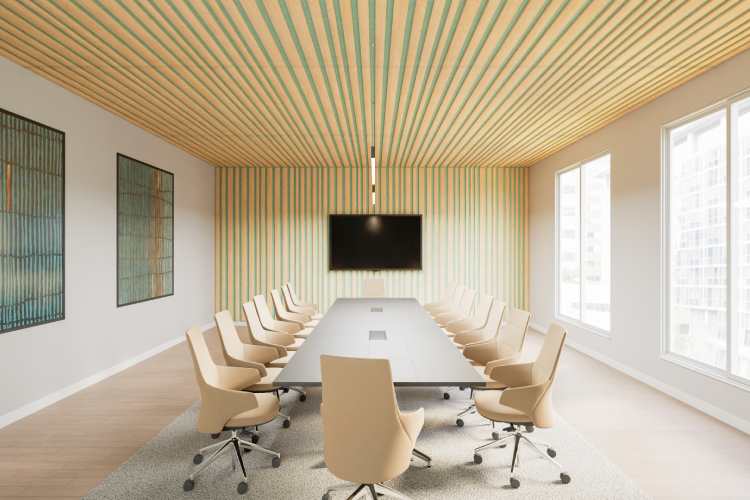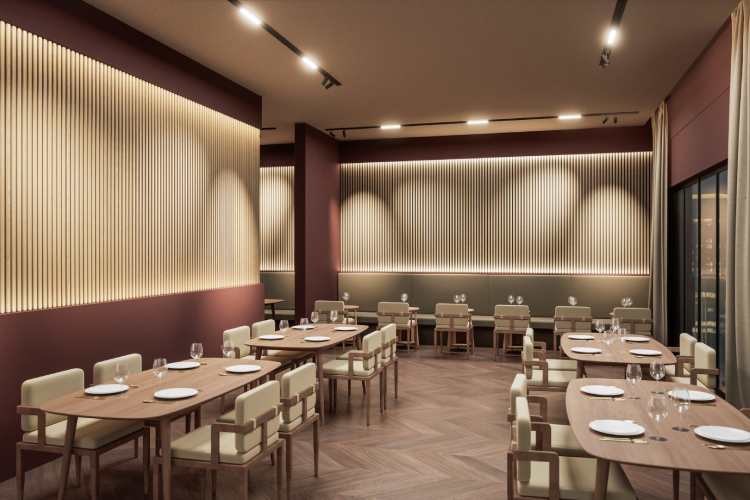Wood
Embrace the timeless beauty and natural properties of wood in your architectural designs. Wood acoustic solutions bring a perfect blend of warmth, sophistication, and biophilic benefits to interior spaces while effectively managing sound reflection and absorption. Available in numerous species, finishes, and cores, wood acoustic treatments offer unparalleled design flexibility while contributing to sustainability initiatives through responsible forestry practices and carbon sequestration—because sometimes the best way to make a space sound amazing is to go against the grain.

Ceiling Panels
Ceiling Tiles
Wall Panels
Why Material LogIQ Wood
Design-Assist From Day One
Share your design intent, acoustic goals, and project timeline. With that in mind, we can recommend panel types, installation methods and backers to hit the mark.
Samples & Submittals, Simplified
Veneer sets, mockups, and performance documentation aligned to your spec.
Made-To-Order Craftsmanship
Tight veneer matching, clean edges, and consistent sheens across large runs.
Install-Friendly Systems
Predictable hardware, detailed shop drawings, and intuitive hardware reduce surprises on site.
Sustainability Options
Low-VOC finishes. FSC®-available veneers upon request.
Frequently Asked Questions
What makes wood acoustic panels “acoustic”?
How much sound do wood acoustic panels absorb?
What’s the difference between micro-perforated and slatted systems?
- Micro-perforated: Very small, tightly spaced holes that appear nearly solid from a distance—great when you want “invisible acoustics.”
- Slatted: Alternating wood slats and gaps over acoustic felt; combines diffusion with absorption and a strong linear aesthetic.
Can wood acoustic panels go on ceilings and walls?
Do you offer acoustic ceiling tiles for T-grid?
We do. Our wood slat ceiling tiles or Slatta Tiles drop into a 15/16″ grid and include factory backers for consistent performance. They’re ideal for retrofits where plenum access is important.
Are the panels real wood?
Choose from solid wood, or real wood veneers on composite wood cores. Veneers deliver authentic grain with better dimensional stability than solid lumber in building environments.
What species and finishes are available?
How are panels installed?
Can panels be removed for maintenance or access?
What about fire rating?
Class A constructions are available using appropriate cores, veneers, and finish systems. We’ll provide documentation for your local AHJ during submittals.
Are wood acoustic panels sustainable?
Options include FSC®-available veneers and low-VOC finishes. Because they double as both finish and acoustic treatment, they can reduce the need for additional materials.
How do they hold up in busy spaces?
With the right finish, wood acoustic panels perform well in high-traffic environments. For added protection, specify abrasion-resistant topcoats and edge banding; consider slats or micro-perf where impact is a concern.
Can we curve or bend the panels?
Yes. We offer CNC-formed and radiused constructions. Share your radius and layout early so we can confirm feasible build-ups and mounting.
Can lighting, sprinklers, and diffusers pass through the ceiling system?
Sometimes. We coordinate openings and trims so MEP devices integrate cleanly without compromising acoustic performance.
What’s your lead time on new projects?
Production times depend on finish, volume, and complexity. Contact us with your schedule. We’ll align sampling, approvals, and fabrication to your milestones.
Do you offer samples and mockups?
We do. Project-specific samples help confirm species, sheen, and perforation/slat choices. On larger projects, consider a jobsite mockup to finalize details.



